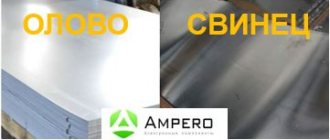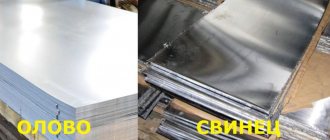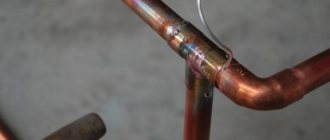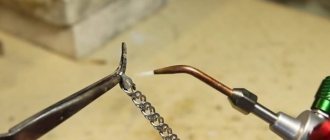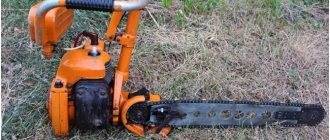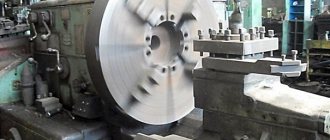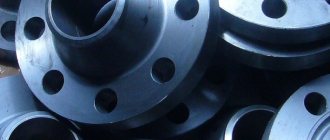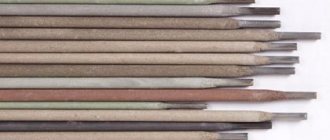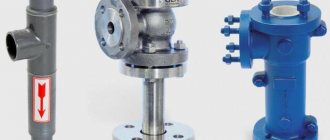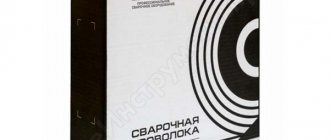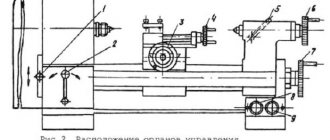Varieties
Silver solders are divided into several varieties depending on their silver content.
Solders with a low content - up to 40% - are used for soldering workpieces made of steel and non-ferrous alloys. Such compositions have insufficient strength to connect parts thicker than 3 mm.
Compositions with an average content of 40 to 60% are used for soldering copper, nickel and steel parts that experience significant static loads, shock and vibration.
Silver solder with a high percentage - from 65% is used when soldering especially critical seams, such as band saws and wire connections. The high silver content allows for excellent electrical conductivity.
Cold-Shop
Copper-phosphorus solders are a copper-based alloy containing phosphorus. The composition of these types of solders is approximately as follows: copper from 80% to 94%, phosphorus from 4 to 9%. In addition, the composition of copper-phosphorus solders may include zinc Zn and tin Sn; their additives help reduce the melting point to 650°C, while the melting temperature of solders without tin and zinc additives ranges from 700-850°C. The higher the phosphorus content, the lower the final melting temperature of the solder. There are also solders with the addition of tin and zirconium, such solders have a reduced melting point, very good fluidity, resistance to aggressive environments, the disadvantages include loss of elasticity of the seam at low temperatures. When soldering copper-copper, copper-phosphorus solders do not require the use of flux and have good fluidity; when soldering copper - copper alloy, it is advisable to use the flux recommended by the manufacturer. A connection made with copper-phosphorus solder has high strength, but does not withstand vibration and deformation loads very well. The advantage of copper-phosphorus solders is their low cost compared to silver solders. Well suited for soldering lightly loaded copper pipelines.
Silver solders - they mean alloys containing silver. Conventionally, two groups of silver solders can be distinguished: silver-copper-phosphorus, and silver-copper.
Silver-copper-phosphorus alloy based on silver and copper with the inclusion of phosphorus. The silver content in such solders is usually from 0.5 to 20%. They have all the positive qualities of copper-phosphorus solders, and the addition of silver lowers the melting point, increases the electrical conductivity of the joint, and can give the joint resistance to vibration and some elasticity to the joint. The higher the silver content, the more flexible the solder joint. For soldering copper-copper and copper-copper alloy, such solders can be used without flux.
Silver-copper alloy based on silver and copper. The silver content is from 0.5 to 80%, the rest is mainly copper, but additions of tin, zinc, lead, zirconium and other elements are possible. Silver-based solders can be used to solder products made of various metals, including their various combinations, such as copper-steel, brass-steel, titanium alloys and stainless steels and others. Depending on the silver content and other additives, solders have different properties. For soldering copper pipelines, it is sufficient to use solders with a silver content of no more than 20% of the solder mass. To connect pipelines with various elements of refrigeration equipment, in which the connecting pipes are made of steel, it is advisable to use solder with a silver content of more than 25%. Joints made with solder with a high silver content, in addition to high strength, have the ability to withstand long-term vibration and dynamic loads. The main disadvantage of silver solders is their high cost.
The most common packaging of solders is round rods of square or rectangular cross-section, 30-50 centimeters long, in cardboard boxes of one kilogram. In addition, the rods can be coated with a layer of flux or contain flux inside the rod; in such cases, the mass of solder is indicated along with the flux.
Our store offers silver and copper-phosphorus solders from well-known manufacturers Saldflux, Felder, Rothenberger. The range of solders is able to satisfy all possible needs for the installation and repair of refrigeration and air conditioning systems.
Physico-chemical properties and composition of silver solder
The properties of a particular silver solder are determined by its composition. Silver solder, which is used for multi-stage soldering, must have a sufficiently high melting point. This is necessary so that during surfacing of the next layer the previous one does not melt and leak into the solder gap. The average melting point is 600 °C.
Chemical composition of silver solders
Properties of silver solders
To create such solder, you will need to take 33 parts of cadmium, 16 parts of zinc and 20 parts of copper for 30 parts of silver. Like any composition with a low content of the main element, it is not resistant to high loads, shocks and vibrations.
Increasing the silver content to 50% will increase the fluidity of the melt and the ability of the solder seam to withstand static and dynamic loads. It can also be used for soldering in several layers, but special care and caution will be required.
Silver solders
Home > Solders > Silver solders
06/25/2012 // Vladimir Trunov
A little theory
I’ll start with a quote from Brepohl: “When making solder, the base should be the eutectic composition of the Ag-Cu alloy and the melting point should be lowered by adding zinc. The difference between the melting temperatures of the base metal and the solder must be at least 50 ° C.”
What is “eutectic alloy composition”? I have already mentioned in the article “Melting point of Ag-Cu-Zn alloys” the terms “liquidus” and “solidus”. I repeat: liquidus is the temperature of complete melting of the alloy when it is heated, and solidus is the temperature of complete solidification of the alloy when it is cooled. For pure metals, these temperatures coincide, and when the melting point is reached, the temperature of the metal remains constant until it completely transforms into a liquid state. In general, alloys have a temperature range in which they are no longer solid, but not yet liquid. The lower boundary of this interval is solidus, the upper boundary is liquidus (from the words “solid” and “liquid”). However, with a certain combination of components, the alloy behaves like a single metal: the solidus and liquidus points coincide. This combination is called eutectic.
From the above diagram (click to enlarge) it can be seen that all alloys with a silver content below 91% begin to melt at the same temperature - 779 ° C, and completely melt differently. And there is one point (72% silver) where the liquidus coincides with the solidus. This is the eutectic for Ag-Cu alloys. This point is the lowest melting point for all these alloys (“eutectic” - Greek for “easily melting”). For Ag-Cu-Zn ternary alloys, this point of interest to us turns into a line, which is highlighted in bold and red on the liquidus isotherm diagram that is already familiar to you. The most suitable alloys for solders are located along this line. Suitable in several senses:
- they contain the minimum amount of zinc required for a given melting point;
- they melt without an intermediate mushy state, which ensures the cleanliness and uniformity of the seam;
- they have a uniform fine-grained structure, which guarantees the strength and ductility of the connection.
That is why Brepol advises taking a eutectic alloy as a base, without, however, explaining anything. Like, if you don’t slurp cabbage soup with bast shoes, you’ll figure it out yourself.
Selecting solders from tables
I mean solders, recipes for which are given in numerous tables. I wrote down those of them where there are no obvious typos, and as many as I had the patience for. And then I processed each one with the Ag-Cu-Zn program and got the table shown in the next picture (click to enlarge). Now is the time to reveal the secret of the parameter hidden under the Greek letter “epsilon”. Following Brepohl’s precept that a good solder composition is a eutectic composition, I decided to introduce into the program an algorithm for calculating a certain parameter that would characterize the “eutecticity” of the alloy. The parameter ε shows the relative deviation of the selected alloy composition from the eutectic one. Ideally, it is equal to one, and its most distant values are from 0.7 to 1.4. Values close to eutectic should be considered approximately from 0.95 to 1.05.
In addition to the melting point and the “eutecticity” parameter, the choice of solder is influenced by another important criterion - its sample. There is not such a strict requirement as for gold that the solder sample coincides with the alloy sample, however, there is a lower threshold beyond which conflicts with the assay inspection may arise. This threshold is 60% silver, i.e., the sample must be at least 600. In addition, its color and resistance to chemical influences depend on the sample of the solder. Based on this, I would like to choose solders of the highest standard possible.
And finally, the most important thing: what are we going to solder? In this case we are talking about silver jewelry alloys. We’ll talk about soldering copper, steel and other metals another time. Let us remember Brepol's second testament: the melting point of the solder must be at least 50 degrees lower than the melting point of the base alloy (here we mean solidus, i.e., the starting point of its melting). For all jewelry alloys below 910 fineness, the solidus is 779 degrees. For 925 sample - 808 degrees, for 916 - 789.
We look at the table: the first four disappear due to too high a temperature, the last four - due to a low sample. Let's start with the choice of brazing solder. For soldering 925 silver, we can afford solder with a melting point of 760 degrees. According to the table, we select compositions 5 and 10: the first - for sample, the second - for “eutecticity”. Then we select soft solder - we simply take the lowest melting point, this is composition 23. The average solder should have a temperature of about 730 degrees. From the table, the best option is probably number 15.
We create our own recipes
However, there is no need to select solders specifically from this or any other table. We have the Ag-Cu-Zn program! We enter the required sample and temperature on its right side and achieve such a combination of them that there is a solution. Then, on the left side of the program, we specify the parameters of the resulting alloy and adjust it to the required ones.
I liked the four solders shown in the last picture. Their temperatures differ by about 20 degrees, and they satisfy almost all needs when soldering silver.
solders, jewelry alloys
Alloys - temperature standards
Melting point of Ag-Cu-Zn alloys
Gold solders
Related Posts
Specifications
The most common silver solders include elements such as Ag, Cu, Zn, Sn, Mn, P, Cd.
| Brand | Availability of elements, % | |||||||||
| Ag | Cu | Zn | Sn | Mn | P | Cd | Impurities, max | |||
| Pb | Fe | |||||||||
| PSr72 | 72 | Track | — | — | — | — | — | 0,005 | 0,1 | |
| PSr71 | 71 | Track | — | — | — | 1 | — | 0,005 | 0,15 | |
| PSr70 | 70 | 26, | Track | — | — | — | — | 0,05 | 0,1 | |
| PSr65 | 65 | 20,0 | Track | — | — | — | — | 0,1 | 0,1 | |
| PSr62 | 62 | 28,0 | — | Track | — | — | — | 0,005 | 0,15 | |
| PSr50 | 50 | Track | — | — | — | — | — | 0,005 | 0,15 | |
| PSr50 Kd | 50 | 16,0 | 16,0 | — | — | — | Track | 0,1 | 0,1 | |
| PSr37.5 | 37,5 | Ost | 5,5 | — | 8,2 | — | — | 0,05 | 0,1 | |
Silver solders with a content higher than 72% are used in jewelry.
Features of choice
Selecting a solder that is best suited to a specific combination of materials, thickness and configuration of workpieces, and requirements for mechanical and thermal loads on the seam is not an easy task. To create strong, durable seams that are resistant to static and dynamic loads, experienced craftsmen recommend choosing silver solder with a medium or high content of noble metal. They may include Ni, Cu and Pb. For soldering pipelines and containers used in refrigerators and air conditioners, only mixtures with a high Ag content are suitable.
Soldering jewelry
When soldering jewelry, the high cost of the base material justifies the use of solders with a silver content of 85 to 100%, or pure silver. This silver solder is produced in the form of wire with a diameter of 1 mm.
When creating seams intended for use at elevated temperatures, compounds containing lead or tin are not suitable. Due to their low melting point, they will weaken the entire connection. In this case, silver-copper soldering materials are chosen.
High percentage of silver
PSR-65 solder, which contains, in addition to the amount of silver indicated in the marking, 20% copper and about 15% zinc, has a narrowly targeted application. They are used to solder band saw blades.
Silver alloy PSR-70 has a high price. The concentration of noble metal in it is 70%. In addition, the composition includes about 26% copper, approximately 3% zinc, 0.1% iron, 0.005% each of lead and bismuth.
This silver solder has good electrical conductivity and is used for soldering electrical components. The connection point of the wires obtained by this method does not significantly reduce the ability of the entire system to conduct current.
The alloys PSr-71 and PSr 72 are similar in elemental composition. They contain 71% and 72%, respectively, of silver. Just over 0.1% is iron, lead and bismuth. PSR-71 solder contains 1% phosphorus.
A composition with a silver concentration of 70-80% is used for repairing jewelry. Other areas of use are limited by the high cost of solder materials with a large amount of noble metal.
Advantages
The melting point of pure silver solder is 962 °C, the seam is ductile and soft. To save precious metal and produce stronger connections, other metal elements are added to the solder.
The advantages of a particular solder depend on the composition and percentage of additives.
The general advantages of silver solders are:
- high fluidity;
- strength;
- corrosion resistance;
- suitability for working with a wide range of materials;
- low resistance to electric current.
The lower the Ag content, the lower the operating temperature of the composition. The labor intensity and energy intensity of soldering are proportionally reduced.
Silver percentage
The silver content of silver solder also affects other physical properties such as thermal and electrical conductivity.
Low content
Compositions with low silver content are widely used in industry for soldering metal workpieces.
They are also used in electrical engineering - a composition containing only 2% Ag, 62% Sn and 36% Pb is very popular in electrical and radio installations.
It is characterized by high conductivity and increased fluidity, which facilitates the soldering process.
Average percentage of silver
Compositions containing from 40 to 60% are recommended for seams operating at low temperatures.
Seams soldered using PSr40 are distinguished not only by their high strength and ductility, but also by their ability to withstand high dynamic and periodic loads.
Solder PSr40
Solder PSr45
PSR45 is used when working with joints up to 3 mm thick. Also resistant to vibration and aggressive environments.
High percentage of silver
PSr65 solder, to which 2% copper and 14% Zn are added, is specially designed for soldering band saw blades. It has increased tensile and bending strength.
The PSr70 composition provides excellent conductivity and is used for soldering critical connections of electrical components and wires. The minimum connection resistance is important both in microelectronics and in powerful electrical installations for industrial use and at generating stations. The high price hinders its widespread use.
Solder PSr60
Solder PSr70
Economic considerations also prevent the wider use of high-silver formulations outside of scientific research, military and jewelry applications.
How and with what help to solder silver?
Before you decide to solder parts of a silver product yourself, you need to understand the physical and chemical properties of the noble metal. The melting point of silver is 960 degrees. This is an average for the various metals used to make jewelry.
The melting point depends on how much pure silver is contained in the alloy. To ensure high-quality soldering, you need to carefully approach the choice of silver solder.
It is a strong solder joint and is used for soldering both non-ferrous and ferrous metals, as well as various alloys. For ease of use, all solders are subject to markings, including an alphanumeric set. The digital indicator determines the amount of silver in the solder as a percentage.
Any seam soldered with solder is resistant to corrosion, does not deform, and is durable. The most important factor of the above is anti-corrosion. To ensure that this point is observed, you should choose solders that have a high content of pure silver.
If it is impossible to purchase solder at special retail outlets, you can make it yourself. The most common and high-quality composition, which includes:
All components are melted in a muffle furnace. After melting, the mixture is poured onto a substrate and passed through a machine to produce sheets of the desired thickness. For soldering, sheets of 1-3 mm are used. Strips of the required length are cut from them.
Read also: Is it possible to cook stainless steel using carbon dioxide semi-automatically?
What fluxes are suitable
To obtain a high-quality and durable seam, it is necessary to treat the surfaces of the workpieces with fluxes before soldering. These auxiliary materials clean the surface of chemical contaminants and oxide film, preventing its reoccurrence.
Fluxes also help increase melt flow and wettability of the workpiece surface with silver solder.
One of the most popular flux materials among solders is borax.
Soldering borax
Solder paste can be prepared as follows:
- Pour borax powder into a heat-resistant mixing container.
- Add water in a thin stream and stir thoroughly.
- Heat until completely transparent.
- Drain the liquid phase, grind the sediment to the consistency of sour cream.
The paste is suitable for silver solders with a melting point from 490 to 910 °C.
A composition containing:
- 35% boric anhydride B2O3;
- 43% KF;
- 22% K₂B₄O₇.
Solder paste
Potassium fluoride is calcined for 3-4 hours, then all components are thoroughly mixed and heated until melted. After cooling, the material is crushed and ground to a fine powder. It should be kept in an airtight container, since it actively absorbs water vapor contained in the air, thereby losing its working qualities.
For soldering porous materials, a flux based on potassium tetrafluoroborate is used. In order to obtain such a composition, you will need to use extremely strong and dangerous hydrofluoric acid.
If you do not have sufficient skills in handling strong chemicals, it is safer to buy the composition in a store.
Technology for creating silver solder at home
When creating solder with your own hands, you will first need to melt silver and other components, and then cast the resulting melt into a special container - ingus.
The process begins with the preparatory phase. A cardboard square is placed at the bottom of the melting spoon, and a sheet is placed on it so that its edges wrap around the edges of the spoon. This is done to speed up the melting process.
Silver solder cutting
Using jewelry or laboratory scales, the charge is weighed and divided into portions of 18-20 g. For one portion, take 6 g of 875 silver and 40% pure metal. Iron dust is removed from the mixture using a strong magnet.
Next you should add finely chopped copper. It is taken at the rate of 1 part copper to 3 parts silver mixture. The flux will be borax powder; it is added to 10% of the total volume.
The next stage is melting. You should light the burner and adjust the combustion mode. The melting spoon is placed in the upper, hottest part of the burner flame. The charge begins to melt and accumulate at the bottom of the melting spoon.
Ingus should be coated in advance with a thin layer of wax, heated and kept ready next to the burner.
Once all the charge has melted, you can begin the final stage - casting.
The spoon is removed from the heat and without the slightest delay, without allowing the molten metal to cool, the spoon is poured into the ingus in one smooth movement. Ingus is cooled with a stream of water. After the casting has completely cooled down and the crystallization processes have completed, it is removed from the ingus, turning it over and knocking if necessary.
When making your own solder, the following precautions should be observed:
- Carry out work in a well-ventilated area.
- Use personal protective equipment: goggles or a transparent shield, protective gloves made of split leather or tarpaulin.
- Carry out work on a fire-resistant base.
- Immediately after heating and casting is completed, turn off the burner.
- Do not leave equipment unattended.
Making silver solder with your own hands is not a very difficult job, but it requires concentration and a certain skill.
Materials and tools for creating solder
To make silver solder yourself, you should prepare the following materials and equipment:
- Silver scrap.
- Additive materials (Zn, Cu, borax as a flux and others according to the recipe).
- Laboratory or jewelry scales.
- Gas burner mounted on a stand that prevents it from tipping over.
- Melting spoon.
- Metal scissors.
- Container and spatula for mixing ingredients.
- Abrasive paper.
- Ingus.
Silver scrap
The table on which work will be carried out must have a fire-resistant coating.
Tin-silver solder
Tin-silver solder
+7 [email protected] u
0 R
- Cart Checkout
- Your basket is empty!
Catalog
- METALS AND ALLOYS
- Aluminum ALUMINUM (AL) SHEETS
- ALUMINUM FOIL
- ALUMINUM (AL) TIRES, STRIPES
- ALUMINUM (AL) TUBES
- ALUMINUM CORNER, CHANNEL, TOBUS AND VARIOUS PROFILES
- ALUMINUM PROFILE for 3D printer DIN912 BOLTS and T-nuts for 3D PRINTERS and CNC
- ALUMINUM PROFILE for 3D printer
- COMPONENTS for 3D PRINTERS and CNC
- 3D PRINTERS
- FILAMENT – FISHING LINE for ABS 3D PRINTER
- HIPS
- SBS
- PLA
- DURALAL D16t SHEETS, PLATES
- BRASS SHEETS
- Copper mesh
- BRONZE SHEETS
- SHEETS AND BANDS STAINLESS STEEL AISI 304
- KNIT SILVER SHEETS
- COUCHILOR SHEETS
- TITANIUM WIRE VT1-0
- Fiberglass fiberglass NON-FOIL SHEET FR-4, STEF Fiberglass sheet FR-4
- Textolite sheet
- SILICA FABRIC
- GLASS FABRIC from -200°С to +550°С
- Glass-reinforced fire-resistant tubes up to +450°C
- TEFLON TAPE - ROLLER
- Polyimide foil
- SILICONE SHEET ELECTRICAL
- PTFE RODS (CIRCLE), length 1 meter
- POLYACETAL RODS
- TEFLON CLOTH WITHOUT STICKY LAYER (roll width 1000 mm, 500 mm)
- POLYIMIDE TAPE, SHEET
- PLEXIGLASS SHEETS
- THERMAL PADS NOMAKON Thermal pads standard series (KPTD 2/1) λ=0.8
- Ceramics based on aluminum nitride. Thermal conductivity 180 W/mK
- PETV-2, PET-155
- Nichrome wire
- Silicone wire
- Cable RK 50
- RKGM
- HEATING CABLE (METERS)
- BPVL, BPVLE
- POS-61, POS-40, POS-63 HIGH FUSE SOLDER (below 450ºС)
- HOT TOOL
- Breadboards and Jumpers
- DIODE BRIDGES
- Varnish for impregnation of windings
- HAND TOOLS SPECIALIZED TOOLS
- SCRAPS
- COMBINED RATCHET WRENCHES
- RETAIN RING PULLERS
- BAGS - ORGANIZERS FOR TOOLS
- TESTER - SAMPLES
- GRILLES AND FILTERS FOR FANS
- RADIAL BALL BEARINGS, manufacturer USSR and RUSSIA
- Copper lugs (TM/TMo)
Information
- Contacts
- Shipping and payment
- Sale
Delivery across Russia
We will deliver your order by courier in Moscow or by express delivery service throughout Russia.
Tags
- ftp
- utp
- twisted pair
- dielectric
- insulating
- insulating material
- wire insulation
- transformer insulation
- control cable
- communication cable
Click on the image to view
Reviews: 0 / Write a review
- Description
- Characteristics
- Reviews
We recommend watching
Cable tie SK - 300 x 4.8 mm (black) pack of 25 pcs.
100 R
UTP PANDUIT TX6A™ 10Gig™ cat. 6A MaTriX white
100 R
Spring for pliers
100 R
Cable tie SK - 300 x 4.8 mm (white) pack of 25 pcs.
100 R
BPDOE 2.5
100 R
Customers who bought Tin-Silver Solder also bought
Liquid gumboil
100 R
Contact Information
- Moscow, Pyatnitskoe highway, 18 TK Mitinsky Radio Market, ground floor, pavilion “71 B” From 9-00 to 18-00, seven days a week
- +7
- +7, Write to WhatsApp
- [email protected]
Information
- About Store
- Privacy Policy
- Useful GOSTs
- Metal calculator
Applications
- home
- Blog
- Blog
© Cable-Garant. Electrical insulating materials. 2021
